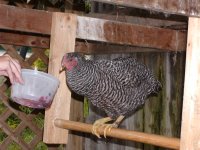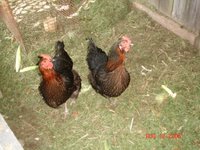Although I've been updating the original posting titled 'Vlad's Suggestions', I felt it was time to create another, separate posting containing those previous updates, as well as the recent ones. After all I don't want people to miss all that I've accomplished, especially this past weekend (8/5 & 8/6, see below) alone.
**** Items highlighted in
green have been tried, completed, read etc
*** Update, June 9, 2006 - This just in...Vlad has refused to provide additional recommendations UNTIL I have acted upon, at least, one of his suggestions below. I was simply asking him for a nice wine recommendation and WHAM he hits me with this ultimatum. Arguably I agreed with him, so off to the book store I go to pick up "The Name of the Rose", afterall I refuse to eat Duck Liver Pate..
*** Update, June 13, 2006 - Well I made it to the book store Friday night and picked up two books - "The Loved One" and "The Name of the Rose". I hope to begin reading The Loved One soon.
*** Update, June 23, 2006 - Tried Gazpacho at lunch today - it's not too bad. I am not a big fan of vegatables in general, therefore since Gazpacho is made from fresh vegetables I didn't enjoy completely. However, the juice was tasty and reminded me of what my mother would call "butta butta", which I believe is Greek for dipping.
*** Update, June 24, 2006 - When Vlad and I made our WholeFood run on Friday to pickup the Gazpacho, I also picked up two Iggy's bagels - one plain and one multigrain. I had the multigrain one this morning toasted with butter - very, very good and tasty bagel! Typically bagels with toping almost alway loose their toping in the process of slicing toasting and buttering but this bagel held onto the majority of it topings.
*** Update, June 25, 2006 - Purchased a six-pack of "Old Speckled Hen" ale today and gave one a try - I enjoyed it, However, very expensive, as I paid $8.50ish for a six-pack...
*** Update, July 3, 2006 - At Vlad's request the "Cîroc® Vodka" needs to be removed from his list of recommendations below. Although this vodka came highly rated by Vlad origionally it has tumbled and it no longer a favorite. Too fruity a taste, which is too overwhelming when consuming this vodka in the quantities that Vlad drinks.
*** Update, July 20, 2006 - Today I tried Salmon caviar. It was meticulously prepared by Vlad himself on a piece of dark bread with plenty of butter. However, there's a bit of a discrepency with this 'tasting'. Apparently, Vlad doesn't believe it was a true tasting because there was "not enough quantity"...go figure.
*** Update, July 31, 2006 - JoAnne purchased, from eBay, "Everything You Always Wanted To Know About Sex But Were Afraid To Ask". We just have to find the time to watch it...it's on the 'list'!
*** Update, August 5 - 6, 2006 - Ok, this weekend I experienced several old (from original list) and some new (just added) of 'Vlad' recommendations:
(1)
A fresh brewed cup of hot tea - we're not talking the Lipton or Tetley tea bag method here. I'm talking about Ceylon Vithanakande FBOPF. Tea that I can't even pronounce but tasty just the same - An extremely complex tea of medium body with fruity, biscuity and honey-chocolate notes, this tea has much to offer!
(2)
Potatoes and Herring w/sour cream - All in all this was a good meal, although I found the Herring to be too salty but the combination of the three were tasty none-the-less.
(3)
Balvenie Scotch Whiskey - as luck would have it Vlad had opened his bottle of 15 year old scotch Friday night. Well here it was Saturday afternoon, perfect timing, and about time for me to give this beverage a try and Vlad was kind enough to offer. Mind you now I am NOT a Scotch drinker and never played one on TV either and up until this point I can only remember tasting whisky once before; Dewar's I think. Perhaps because I 'shot' it down too fast, or I was too young to appreciate it but the end result was nasty, besides the fact that my throat was on fire - Ok, so I'm a weenie. Ah, but here we are 15 years later and with a bottle of 15 year old Scotch and maybe just maybe I've matured a little... I give it two thumbs up! Of course I have nothing to compare it to and realize that drinking Scotch is an acquired taste, which I will now work on (don't tell JoAnne) but I enjoyed it just the same. Unfortunately, trying and liking this Scotch doesn't make me any less of a weenie...
Footnote: Sylvester is a weenie too! He's a Scotch drinker who didn't care too much for this particular scotch. Perhaps if he put the bottle in a brown paper bag it would taste better to him (hehehe)(4) Foie Gras [FWAH GRAH] (
Duck Liver Pate) with Truffle - Giddy up!! Yes sir, I gave this dish a whirl!! Actually and much to my surprise it was quite tasty and delicious...I kid you not. It was prepared on a nice fresh piece of French bread and perhaps because it was in a spread form, palatable. I could taste the truffle, which enhanced the taste and allowed me to pretend I was eating some creamy chocolate candy. Now trying this
DOES make me less of a weenie - others might not agree but in my book it does!
(5) I found 15 minutes on Sunday morning to read one of Charles Bukowski's short stories - "
Six Inches". All I will say is if the rest of his stories are as 'unique' as this one, I'll continue reading them.
(6) Last but not least Vlad had one more surprise in store. Out of the fridge came this science project looking arrangement. It was a Tupperware bowl half filled, with a saucer turned upside down on top and a mason jar filled with water sitting on the saucer all stuffed in a plastic bag. In the bowl were wild mushrooms (Russule) soaking in a water type marinade - freshly picked mushrooms, by Vlad and his wife, from somewhere (it's a secret) in Western Massachusetts. Faced with pier pressure once again, I caved and tried one and yet again I was pleasantly surprised by the taste and actually liked it, WOW! At this pace I won't be a weenie too much longer...giter dun!
*** Update, August 13, 2006 - We finally found some time to watch 'Everything You Always Wanted to Know About Sex but Were Afraid to Ask'. However, and maybe because it was on the later side, but we only got through the first three skits. JoAnne fell asleep early on and I eventually followed suit. JoAnne's rates this as unwatchable. I will reserve my feedback until after I give it one try.
*** Update, August 31, 2006 - Sylvester reported in today on the Satsabeli / Georgian Sauce. He and his wife give it two thumbs up. Vlad will be visiting his favorite Russian store this weekend and has agreed to pick me up a bottle - I can't wait.
**** Movies ****
- "Everything You Always Wanted To Know About Sex But Were Afraid To Ask" - starring: Woody Allen, Tony Randall, Lynn Redgrave, Gene Wilder & Burt Reynolds
- Black Cat White Cat (1999) - starring: Bajram Severdzan and Srdjan Todo
**** Foods ****
Iggy's Bagel - "Iggy's Bread of the World" is at 130 Fawcett St., Cambridge, 617-491-7600. Iggy's bagels are sold at many Whole Foods Markets
Foie Gras [FWAH GRAH] (Duck Liver Pate) with Truffles...I'll be passing on this one, YUK!
Avocado - Cut in half, add salt, use spoon to scoop and eat.
Gazpacho - A Spanish-style soup that resembles a sort of chunky liquid salad, with lots of fresh, uncooked vegetables suspended in a broth of pureed tomatoes or tomato juice and chicken stock.
Pelmini - Are a national Eastern European (mainly Russian) dish - usually made with minced meat filling, wrapped in thin dough (made out of flour and eggs, sometimes with milk or water added). Pork, lamb, beef or any other kind of meat can be used as a filling and mixing several kinds is popular.
Pelmeni belong to the family of dumplings.
Potatoes and Herring - Boiled potatoes, Herring and Sour Cream
Satsabeli / Georgian Sauce
**** Wine/Beer/Liquor/Beverage ****
**** Books/Readings/Author's ****
Haiku
Evelyn Waugh - "The Loved One", "A Handful of Dust", "Put Our More Flags"
Umberto Eco - "Granita", "Misreadings", "The Name of The Rose"
Vladimir Nabokov - "Lolita
Gabriel García Márquez - "One Hundred Years of Solitude"
Paulo Coelho's
His Divine Grace A.C. Bhaktivedanta SwamiPrabhupada - "Bhagavad Gita"
Charles Bukowski - "The Most Beautiful Woman in Town and other short stories" - (Six Inches, The ? Machine)
**** Miscellaneous ****




















